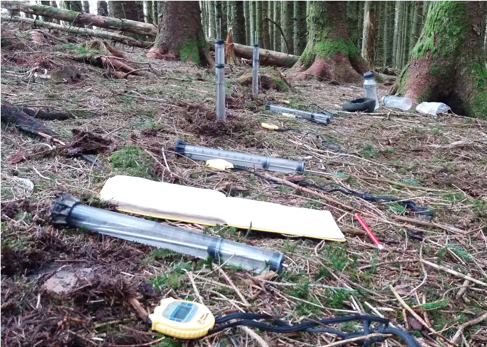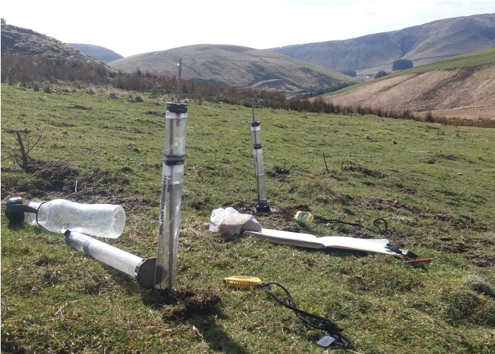Authors: Robinson DA1 and Marshall M1
Reviewers: Jones SB2
Measurement unit: cm day-1; Measurement scale: plot; Equipment costs: €€; Running costs: €; Installation effort: low; Maintenance effort: low; Knowledge need: moderate; Measurement mode: manual
Soil hydraulic conductivity depends on soil structure and water content. Hydraulic conductivity controls the water-flow rate through soil and the time to ponding when water at the soil surface is partitioned between infiltration and runoff. Hydraulic conductivity is treated as a parameter in most models, however, it is increasingly recognised that changes to structure brought about by tillage, vegetation, and climate and land-use change make it a variable and subject to feedbacks (Robinson et al., 2019). Climate change, especially extreme events such as flood and drought, can change the soil structure and hence alter the speed at which water enters the soil and affect the partitioning. This is important because any soil water which runs off, or is directly evaporated, is transferred to the biological soil moisture pool and is not available for transpiration. Typical values of soil hydraulic conductivity are 500 cm day-1 for sand, 50 cm day‑1 for loam, and 5 cm or less day-1 for clay. These values are important input parameters for soil hydraulic models such as HYDRUS-1D (Šimůnek et al., 2008).
3.2.1 What and how to measure?
Soil infiltrometers
Soil hydraulic conductivity can be measured in the field or in the laboratory. The preferred method is in the field because this is minimally invasive as it does not require the removal of a soil core. Saturated soil hydraulic conductivity measurements (made in the lab) are generally used as a reference value, although soils are rarely saturated except below the water table. Measurement of hydraulic conductivity near saturation can be highly variable depending on the presence of macropores: many researchers use tension-infiltrometers to eliminate macropore flow from the measurement (Angulo-Jaramillo et al., 2000). Field estimates of hydraulic conductivity using infiltrometers are not typically fully saturated due to trapped air, providing only approximate values of saturated hydraulic conductivity. Furthermore, long-term infiltration rates are generally not well-captured by infiltrometers with small water reservoirs. Models are used to fit infiltration data to hydraulic parameters such as infiltration rate, sorptivity, and soil hydraulic conductivity (Mualem, 1986; Šimůnek et al., 2003). A range of disc tension-infiltrometers is available, with mini-disc infiltrometers proving optimal for plot-level work as they have a small disc that causes minimal impact on soils. Mini-disc infiltrometers can be read manually or attached to pressure transducers for multiple simultaneous measurements (Madsen & Chandler, 2007). Each measurement typically takes 30 minutes and will depend on the soil type. Multiple measurements per plot will be required to account for spatial variability.
Where to start
Mini-disc infiltrometers are arguably the easiest place to start – Madsen & Chandler (2007) (see Figure 3.2.1). These simple and easy-to-use devices can provide estimates of unsaturated hydraulic conductivity at tensions between 1 and 6 cm. The pdf guide is helpful (https://www.metergroup.com/environment/products/mini-disk-infiltrometer/). Some background to the measurements can be found in Angulo-Jaramillo et al. (2000), Mualem (1986), and Šimůnek et al. (2003, 2008).
 |
 |
| Figure 3.2.1 Setup of infiltration measurements in a forest (left) and on a grassland soil (right) using mini-disk infiltrometers and stop watches. Photo: Francis Parry (Centre for Ecology & Hydrology). | |
3.2.2 Special cases, emerging issues, and challenges
Ensure the base is clean and unobstructed to water flow before priming the infiltrometer. Create a level surface of native soil or fine sand, perhaps 2 mm thick, to ensure a fully hydraulically conducting interface across the entire area of the infiltrometer. To work properly, good hydraulic contact must be maintained and the infiltrometer should be positioned vertically and not leaning.
3.2.3 References
Theory, significance, and large datasets
Durner (1994), Jarvis et al. (2013), Mualem (1976), Nielsen et al. (1973), Porporato et al. (2004), Robinson et al. (2016), Schaap & Leij (1998), Schaap et al. (2001), van Genuchten (1980)
More on methods and existing protocols
Amoozegar & Warrick (1986), Decagon, (2017), Mualem (1986)
All references
Amoozegar, A., & Warrick, A. W. (1986). Hydraulic conductivity of saturated soils: field methods. In A. Klute (Ed.), Methods of Soil Analysis: Part 1—Physical and Mineralogical Methods (pp. 735-770). Soil Science Society of America.
Angulo-Jaramillo, R., Vandervaere, J. P., Roulier, S., Thony, J. L., Gaudet, J. P., & Vauclin, M. (2000). Field measurement of soil surface hydraulic properties by disc and ring infiltrometers: A review and recent developments. Soil and Tillage Research, 55(1), 1-29.
Decagon. (2017) http://manuals.decagon.com/Manuals/10564_Mini%20Disk%20Infiltrometer_Web.pdf
Durner, W. (1994). Hydraulic conductivity estimation for soils with heterogeneous pore structure. Water Resources Research, 30(2), 211-223.
Jarvis, N., Koestel, J., Messing, I., Moeys, J., & Lindahl, A. (2013). Influence of soil, land use and climatic factors on the hydraulic conductivity of soil. Hydrology and Earth System Sciences, 17(12), 5185-5195.
Madsen, M. D., & Chandler, D. G. (2007). Automation and use of mini disk infiltrometers. Soil Science Society of America Journal, 71(5), 1469-1472.
Mualem, Y. (1976). A new model for predicting the hydraulic conductivity of unsaturated porous media. Water Resources Research, 12(3), 513-522.
Mualem, Y. (1986). Hydraulic conductivity of unsaturated soils: prediction and formulas. In A. Klute (Ed.), Methods of Soil Analysis: Part 1—Physical and Mineralogical Methods (pp. 799-823). Soil Science Society of America.
Nielsen, D. R., Biggar, J. W., & Erh, K. T. (1973). Spatial variability of field-measured soil-water properties. Hilgardia, 42(7), 215-259.
Porporato, A., Daly, E., & Rodriguez-Iturbe, I. (2004). Soil water balance and ecosystem response to climate change. The American Naturalist, 164(5), 625-632.
Robinson, D. A., Jones, S. B., Lebron, I., Reinsch, S., Domínguez, M. T., Smith, A. R., … Emmett, B. A. (2016). Experimental evidence for drought induced alternative stable states of soil moisture. Scientific Reports, 6, 20018.
Robinson, D. A., Hopmans, J. W., Filipovic, V., van der Ploeg, M., Lebron, I., Jones, S. B., … Tuller, M. (2019). Global environmental changes impact soil hydraulic functions through biophysical feedbacks. Global Change Biology. https://doi.org/10.1111/gcb.14626
Schaap, M. G., & Leij, F. J. (1998). Using neural networks to predict soil water retention and soil hydraulic conductivity. Soil and Tillage Research, 47(1), 37-42.
Schaap, M. G., Leij, F. J., & van Genuchten, M. T. (2001). ROSETTA: a computer program for estimating soil hydraulic parameters with hierarchical pedotransfer functions. Journal of Hydrology, 251(3), 163-176.
Šimůnek, J., Jarvis, N. J., van Genuchten, M. T., & Gärdenäs, A. (2003). Review and comparison of models for describing non-equilibrium and preferential flow and transport in the vadose zone. Journal of Hydrology, 272(1), 14-35.
Šimůnek, J., van Genuchten, M. T., & Šejna, M. (2008). Development and applications of the HYDRUS and STANMOD software packages and related codes. Vadose Zone Journal, 7(2), 587-600.
Van Genuchten, M. T. (1980). A closed-form equation for predicting the hydraulic conductivity of unsaturated soils. Soil Science Society of America Journal, 44(5), 892-898.
Authors: Robinson DA1, Marshall M1
Reviewers: Jones SB2
Affiliations
1 Centre for Ecology & Hydrology, Environment Centre Wales, Bangor, UK
2 Department of Plants, Soils and Climate, Utah State University, Logan, USA